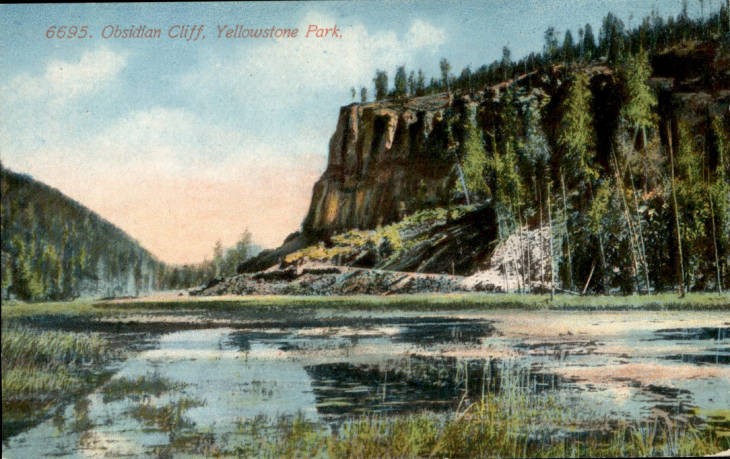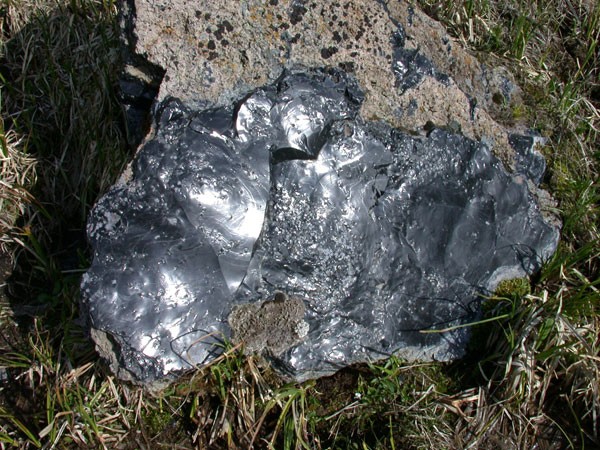Obsidian Cliff
Introduction
Text-to-speech Audio
Images
Obsidian Cliff with Grand Loop Road in the foreground.

The Obsidian Cliff Kiosk, built in 1931, provides needed context.

An early 20th century postcard featuring Obsidian Cliff.

A raw piece of obsidian.

And obsidian that has been worked into a spearhead.

Backstory and Context
Text-to-speech Audio
48YE433, as it is known to archeologists, formed approximately 180,000 years ago when a rhyolite lava flow extruded from the earth’s surface and cooled before mineral crystals could form creating a glass like substance called obsidian. This magma rich with silica has a conchoidal fracture pattern or one with no preferred direction of fracture. When impacted, this volcanic glass fractures easily, forming sharp edges up to ten times sharper than surgical steel. As recently discovered, it also can be analyzed for its chemical composition which provides a unique signature or fingerprint. This feature allows archeologists and geologist to determine where the volcanic glass from Obsidian Cliff was dispersed far from present day Wyoming.
Forming at an elevation of 7,400 feet, Obsidian Cliff eventually rose to a height of 150-200 feet and extended for almost two miles. It was eventually covered by glaciers until the Yellowstone ice cap retreated 12,000 to 14,000 years ago. Shortly thereafter, in geological terms, prehistoric humans stumbled across the outcrop and soon realized the value of the obsidian found there. It is believed members of the Clovis culture first began utilizing the obsidian about 12,000 years ago. Perhaps they initially used the obsidian to sharpen sticks to use as tools. What they certainly did not know was that they had just discovered the richest source of obsidian in North America.
Over the centuries, prehistoric peoples found more and more uses for the obsidian, how to properly cleave it to create spear and arrow heads, and its value to others. As the archeological work at the site in 1986 revealed, various groups established locations, or loci, where they extracted obsidian, either from the surface or with some excavations, and either with or without workshops to fashion the obsidian to their needs.
Since obsidian has a distinct chemical fingerprint, archeologists were able to determine that obsidian which originated here made its way to the Great Lakes region and beyond. This fact reveals the extent of the prehistoric trading system. About 90% of the obsidian found in the Hopewell mortuary sites in the Ohio River Valley came from Obsidian Cliff. The Hopewell were a sedentary tribe who lived in wattle and daub dwellings with thatch roofs and were one of the earliest agricultural groups in North America. A cache of 660 pounds of Wyoming obsidian was located at one of their former village sites. How the obsidian was transported is not known, but by foot and along waterways are fair assumptions. It is also speculated that the obsidian was not traded directly with the end user. There were, perhaps, middlemen involved.
Yellowstone National Park was established in 1872 which, among other things, protected Obsidian Cliff from alteration or destruction. It also allowed amateur archeologists to poke around Obsidian Cliff for decades prior to the arrival of an official team from Montana State University and the National Park Service in 1986. Their work was assisted by a fire in 1988 that removed most of the brush and trees from Obsidian Cliff. The team located numerous prehistoric excavation sites and began the process of tracking the volcanic glass to far flung locations across North America. They also established the fact that the obsidian was used for both utilitarian and ceremonial purposes and became quite valuable to local peoples as a source of tools and weapons as well as for cultural reasons.
Sources
Johnson, Ann, Leslie Davis & Stephen Aaberg. "National Historic Landmark Nomination Form: Obsidian Cliff." United States Department of the Interior/National Park Service. January 28, 1993. Accessed May 15, 2020. https://npgallery.nps.gov/NRHP/GetAsset/NHLS/96000973_text
Park, Robin. "Obsidian: The MVP of Yellowstone's 'Stones." National Park Service, April 10, 2019. Accessed May 15, 2020. https://www.nps.gov/articles/archeology-obsidian-mvp-yellowstone-stones.htm
Smith, Daniel. "Black Gold: The Obsidian Cliff Legacy." This is Yellowstone. 2016. Accessed May 15, 2020. https://thisisyellowstone.com/obsidian-cliff-legacy
